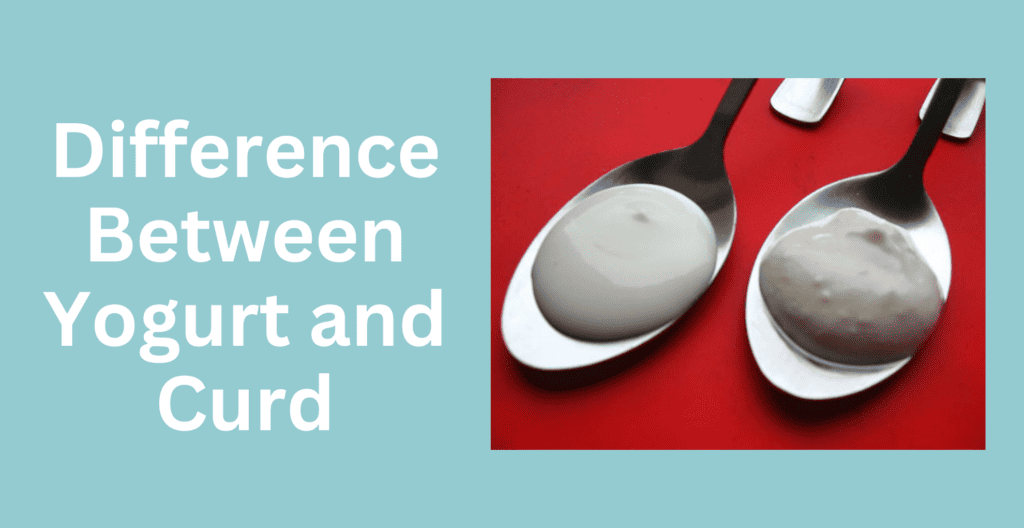Most of us were today years old when we found out yogurt isn’t just a fancy term for curd but actually has stark differences. The two ingredients do fall under the large umbrella of dairy, however there are significant differences between them which mainly lies in their fermentation process.
We have all intermingled the words yoghurt with curd and sometimes vice versa, but did it ever strike you that these are two different entities?
Yogurt is a dairy product produced by the bacterial fermentation of milk, where specific bacteria cultures are used, such as Lactobacillus bulgaricus and Streptococcus thermophilus. The fermentation process of these bacteria turns lactose, the natural sugar in milk, into lactic acid, which acts on milk protein to give yoghurt its texture and tangy taste. Originating from the Middle East and Mediterranean regions, yoghurt is known for its creamy consistency and is often used in a variety of cuisines around the world. It’s also associated with numerous health benefits, including improved digestion and strengthening of the immune system, thanks to the presence of these live cultures.
What is Curd?
Curd, most commonly known as dahi in most Indian household appears regularly in several of dishes and meals. In some countries like India, curd is made by curdling milk with an edible acidic substance like vinegar or lemon juice, but more commonly by adding small amount of already existing curd. The process involves the bacterial fermentation of milk which turn lactose into lactic acid. This is followed by leaving the milk at room temperature for the bacteria to multiply and mature the milk into curd. The types of bacteria that cause the fermentation can vary, meaning curd’s taste, texture, and nutritional benefits can differ widely. Curd is a staple in many Indian households and is known for its benefits of cooling properties and versatility in savory and sweet dishes.
What is Yogurt?
Yogurt is a dairy product produced by the bacterial fermentation of milk, where specific bacteria cultures are used, such as Lactobacillus bulgaricus and Streptococcus thermophilus. The process of fermentation turns the bacteria of lactose into lactic acid which gives the tangy flavor to yogurt along with introducing probiotics into it. Originating from the Middle East and Mediterranean regions, yoghurt is known for its creamy consistency and is often used in a variety of cuisines around the world. The content of yogurt is rich in essential minerals and vitamins such as potassium, magnesium, phosphorus, zinc and Vitamin A, B & D. It’s also associated with numerous health benefits, including improved digestion and strengthening of the immune system, thanks to the presence of these live cultures.
Is Yogurt and Curd Same?
Yogurt vs curd sit on the dairy shelf like two peas in a pod, yet they are factors that signifcantly distinct them from each other. Both the milk products are cherished as staples in different households and are admired throughout because of their creamy textures and tangy flavors. However, the extraction of the two ingredients varies in terms of origin and processing methods.
Yogurt, often deemed a gift from the ancient Middle East, is a product of intentional fermentation by specific bacteria strains, namely Lactobacillus bulgaricus and Streptococcus thermophilus. This process of pasteurization and fermentation involved in the making of yogurt gives it the typical tangy flavor and a creamy consistency. In the modern diet, yogurt is celebrated not only for its versatility in the kitchen but also for its probiotic properties, offering a host of health benefits that include digestive wellness and immune support.
Curd, on the other hand, is also prepared through a similar method of fermentation but is more popular in the Indian context rather than worldwide. In the Indian subcontinent, ‘curd’ refers to what is traditionally known as ‘dahi’, a homemade specialty cultivated by introducing a lactic acid culture to milk, often from a spoonful of the already existing curd. The characteristics of the curd made through the process is diverse and varies in taste, texture, and acidity.
While yogurt’s production is often industrial and standardized, curd has more of artisanal roots, which gives away a local flavor and is generally not mass produced. The debate of yogurt vs. curd is not just about taste or texture but also about the tradition and the personal touch that goes into making curd.
Despite the difference between yogurt and curd, they are both simultaneously enjoyed and have equally amazing health benefits. They are both admired abundantly through smoothies, marinades, dips to desserts.
Yogurt vs Curd – Key Differences
Both the ingredients of yogurt vs curd stem from the milk, however there are many factors that set them apart. Curd is made by fermenting milk with lactic acid bacteria lemon juice or vinegar to milk or by incorporating a bit of already existing curd. Meanwhile, yogurt is fermented using the bacterias of Lactobacillus bulgaricus and Streptococcus thermophilus and thus it is also not feasible to make yogurt at home. The differences in yogurt vs. curd goes beyond just the method of preparation. For instance, the content of lactose is significantly higher in curd than yogurt. Also curd doesn’t come in many flavors and is enjoyed mostly with sugar or salt, whereas yogurt comes in multiple fruit flavors. Curd is also more mild and loose in texture than yogurt. The differences between yogurt vs curd are plenty, however they are both rich in probiotics and provide ample health benefits.
| Yoghurt | Curd | |
| Method to Prepare | Made by fermenting milk with specific cultures (Lactobacillus bulgaricus and Streptococcus thermophilus) at controlled temperatures. | Made by adding an acidic substance to milk or mixing in a bit of the previous batch’s curd, with less control over fermentation conditions. |
| Nutritional Value | Often fortified with vitamins; it contains consistent levels of probiotics and can be lower in lactose | Similar to milk but can vary depending on the bacteria present; natural source of calcium and vitamins from milk. |
| Flavors | Has a consistent, mildly tangy taste due to standardized bacterial strains. | Flavour can vary from mild to tart, depending on the local bacteria and fermentation length. |
| Amount of Lactose | Generally lower due to the efficiency of the bacterial strains in fermenting lactose. | It can be variable; homemade curd may retain more lactose due to less controlled fermentation. |
| Industrial vs Homemade | Commercially produced with a standardized process, available in various flavors and textures. | Often homemade, leading to more variation; commercial versions are less common and can vary regionally. |
| Consistency | Uniformly creamy and smooth, can be thickened further to make Greek yogurt. | Can range from creamy to lumpy, with a less uniform texture that varies with each batch. |
1. Method to Prepare
The difference between yogurt vs curd initially in their preparation. The preparation methods in yogurt vs curd differ primarily in the cultures used to perform the fermentation process and the conditions under which this fermentation occurs. The key yoghurt and curd difference is that the preparation method of curd is less controlled, while yogurt is minutely controlled during preparation.
Yogurt:
Yoghurt is prepared by heating milk to about 80-85 degrees Celsius to reduce the milk proteins, which helps set the yoghurt. After heating, the milk is cooled to about 45 degrees Celsius, where the yoghurt cultures multiply. The specific bacteria are added, usually Lactobacillus bulgaricus and Streptococcus thermophilus. The milk is kept at this warm temperature for several hours to allow the bacteria to convert the lactose into lactic acid, which provides thickness to the milk and gives yoghurt its sour flavour. This process is carefully controlled to ensure the consistency and quality of the yoghurt and this is where the difference between yogurt and curd lies.
Curd:
Curd is made by boiling and cooling the milk to a lukewarm temperature. Then, a small amount of already existing curd which contains live bacterias is introduced into the milk, the possess of which is known as inoculation. This could also be substituted with other acidic substances like lemon juice or vinegar. The mixture is then left undisturbed in a warm place or even room temperature to allow the bacteria to turn the lactose into lactic acid. The process is less controlled than yoghurt making, which can lead to contrasts in the texture and taste of the curd marking the yogurt and curd difference. Read more about the Curd Nutrition.
2. Nutritional Value
There is not much difference between yogurt and curd with respect to their nutritional profile since they both originate from milk. However, yoghurt and curd difference in nutrients exist only slightly because of the varied bacteria and preparation methods.
Probiotics:
- Yoghurt: Yogurt often contains a more consistent level of probiotics, especially if labelled with “live and active cultures.” These probiotics, like Lactobacillus bulgaricus and Streptococcus thermophilus, aid digestion and enhance gut health.
- Curd: The probiotic content in curd can vary since it depends on the natural bacteria in the environment or the already existing curd which was added initially. Homemade curd may have a wider variety of bacteria, but the levels and types of probiotics are not standardized. One can utilise both yogurt and Curd for weight loss given their protein content.
Nutrients:
- Yoghurt: Commercial yoghurts are sometimes coated with additional nutrients such as vitamin D and extra calcium.
- Curd: The nutritional difference between yogurt and curd is that the nutrients present in later is completely natural. They are mostly those that are found in milk such as calcium or phosphorus.
3. Flavors
The flavor difference between yogurt and curd largely comes from the types of bacteria used in their fermentation processes and the conditions under which they are made. The yoghurt and curd difference lies in the sourness where yogurt has a less sour or acidic taste than curd.
Yogurt:
The flavour of yoghurt is typically characterized by a consistent, mildly tangy taste that is because of the bacterias used in its production which are Lactobacillus bulgaricus and Streptococcus thermophilus. These bacteria are used for their ability to produce a specific flavour and ensure that each batch of yoghurt has a similar taste. The fermentation is controlled to stop at the right time to maintain this taste, and the final product is generally smooth with a clean, defined sourness.
Curd:
Curd, on the other hand, can have a variable flavour profile. Since it is often made at home using a small amount of the previous curd to make new curd, the types of bacteria can vary, affecting the final taste. The flavour of curd can range from a mild sourness to a more strong tang, depending on the length of the fermentation and the temperature at which it is kept which defines the yogurt and curd difference.
4. Amount of Lactose
The difference between yogurt and curd lies in the fermentation processes that reduce their lactose content compared to milk. Still, the yogurt and curd difference in terms of lactose content can vary due to the different bacterial cultures involved and the conditions under which they ferment.
Yogurt:
The lactose content in yoghurt is typically lower due to the action of the specific bacterias used in its production. Lactobacillus bulgaricus and Streptococcus thermophilus are particularly efficient at turning lactose into lactic acid.
Curd:
Curd is made by adding a lactic acid bacteria to milk, which could be from previously existing curd or an acidic substance. The bacteria in the culture will also convert lactose into lactic acid, but the extent of this conversion can be less controlled than in yoghurt and this is where the difference between yogurt and curd exists.
5. Industrial vs Homemade
The distinction between industrial and homemade production processes in yoghurt vs curd is notable in their standardization, scalability, and regional preferences.
Yogurt:
The difference between yogurt and curd lies in their production. The production of yoghurt is highly controlled and follows a standard process to ensure consistency in taste, texture, and nutritional content. Large-scale yoghurt manufacturing involves pasteurizing the milk to eliminate harmful bacteria, homogenizing it to provide a uniform surface, and fermenting it with specific strains of bacteria. The process is closely monitored for factors such as temperature and pH levels. The yoghurt is then cooled, packaged, and sometimes fortified with additional nutrients or probiotics.
Curd:
Homemade curd, particularly in South Asian countries, is made by boiling milk, cooling it, and adding a small amount of live curd. The milk is left at a warm temperature to set, relying on the bacteria present in the air or the bacteria from the already existing curd for fermentation. Each pack can taste different due to varying strains of bacteria and fermentation process that stresses more on the yogurt and curd difference. Read to know whether curd is good for diabetes.
6. Regional Differences
We are talking about yogurt vs curd and looking at yogurt and curd difference, which can be significantly noticed with regional differences.
- Yogurt as a product has a higher level of standardization, and it is recognized and controlled in many nations. It is widespread in Western nations.
- Various types of fermented milk products are known as “curd” in many parts of the world, particularly in South Asia. It might include a greater range of tastes and textures. And this is one of the differentiating aspects of yogurt vs curd.
7. Consistency
The consistency in yogurt vs curd can be quite different due to the specific cultures used in fermentation, the fermentation process itself, and the handling of the product after fermentation.
Yogurt:
Yoghurt typically has a creamy and smooth consistency due to the specific bacterias used in its making and the industrial homogenization process that equally distributes fat molecules throughout the product. Read more about yogurt nutrition.
Curd:
Curd’s consistency can vary significantly because it is often made in less controlled environments, such as home kitchens. The type of milk used, the amount of acidic agent (like lemon juice or vinegar), the temperature at which the milk is set, and the length of time allowed for fermentation all affect the final texture of the curd marking all the difference between yogurt and curd.
| Yoghurt | Curd | |
| Method to Prepare | Made by fermenting milk with specific cultures (Lactobacillus bulgaricus and Streptococcus thermophilus) at controlled temperatures. | Made by adding an acidic substance to milk or mixing in a bit of the previous batch’s curd, with less control over fermentation conditions. |
| Nutritional Value | Often fortified with vitamins; it contains consistent levels of probiotics and can be lower in lactose | Similar to milk but can vary depending on the bacteria present; natural source of calcium and vitamins from milk. |
| Flavors | Has a consistent, mildly tangy taste due to standardized bacterial strains. | Flavour can vary from mild to tart, depending on the local bacteria and fermentation length. |
| Amount of Lactose | Generally lower due to the efficiency of the bacterial strains in fermenting lactose. | It can be variable; homemade curd may retain more lactose due to less controlled fermentation. |
| Industrial vs Homemade | Commercially produced with a standardized process, available in various flavors and textures. | Often homemade, leading to more variation; commercial versions are less common and can vary regionally. |
| Consistency | Uniformly creamy and smooth, can be thickened further to make Greek yogurt. | Can range from creamy to lumpy, with a less uniform texture that varies with each batch. |
This table provides a snapshot of the critical difference between yogurt and curd, highlighting how methods of preparation, nutritional content, flavours, lactose content, the scale of production, and consistency differ between the two dairy products, i.e. yogurt vs curd.
Health Benefits of Yogurt vs Curd
Despite the difference between yogurt and curd, the source of origin for both ingredients remains the same, which is milk. Milk itself is a powerhouse of several nutrients and thus both yogurt and curd differences fade out when it comes to health benefits as they both contain plenty. The probiotic content in both the ingredients is exponentially help in promoting gut bacteria.and facilitate regular bowel movements. Below mentioned are some of the benefits of yogurt vs curd.
Health Benefits of Yogurt
The tasteful bowl of yogurt is much more than just a delicious scoop. The ingredient comes loaded with the benefits of vitamin B, phosphorus, potassium and magnesium. Consumption of yogurt is linked to enhancing satiety, improving metabolism, strengthening bones and assist with weight loss.
- Probiotics: The probiotics present in yogurt contain beneficial bacteria that improves gut health and aid digestion.
- Nutrient-rich: The content of yogurt is rich in calcium, vitamins B6 and B12, riboflavin, potassium, and magnesium.
- Immune System Support: Yogurt is rich in magnesium, selenium and zinc which helps in boosting immunity. The properties of yogurt are also known to protect against gastrointestinal infections, respiratory issues and more.
- Weight Management: The protein content in the ingredient helps to promote satiety and suppress hunger which prevents binge eating and assists with weight loss. The item is also known to have a fat burning tendency which further assists with weight management.
- Bone Health: Yogurt is a rich source of calcium and vitamin D, the nutrients that play a key role in improving bone health. They help to preserve bone mass and strength and thus reduce the risk of fractures and osteoporosis.
Health Benefits of Curd
The desi delight of curd offers a mouthwatering taste and is known to have a versatile nature and can be added into several recipes. It is often consumed with sugar, jaggery or recipe or added into smoothies and salads to enhance the taste and health benefits. Curd is known to promote skin, hair, vaginal and bone health. Below mentioned are some of the benefits of curd which ensures overall growth and well being of health.
- Digestion: Curd is a rich source of probiotics which promotes the growth of healthy gut bacteria that improves digestion and facilitates better gut health. .
- Nutrient Absorption: the optimal digestion promoted through probiotics assists with better absorption of nutrients. They also help in regulating bowel movements.
- Bone Strength: The content of curd is rich in calcium and phosphorus which helps in promoting healthy bones and teeth. They also reduce the risks of fractures, osteoporosis and dental cavities.
- Skin and Hair Health: The presence of zinc, Vitamin C, and calcium in curd helps in nourishing the skin and providing moisture to it. Curd is often used in traditional skin and hair care remedies. Curd is helpful in smoothening hair follicles along with strengthening them.
- Prevents Vaginal Infection: Curd contains lactobacillus which helps in restoring the yeast balance of the vagina and promotes vaginal health, keeping several infections at bay.
Which is better – Yogurt vs Curd?
Now that we have settled the debate of, is yogurt and curd same, let jump on to another doubt. People are often confused about choosing the better option between yogurt and curd. On one hand, yogurt is an industrially produced ingredient that requires a meticulously monitored method of preparation. The ingredient comes packed with the benefits of calcium, zinc, B vitamins, and probiotics. The food is also rich in protein which helps promote satiety and suppresses hunger that assists with weight management significantly. Curd on the other hand is more of a homemade ingredient which also possesses probiotics, vitamin B12 and vitamin A, calcium, sodium, magnesium and potassium. All of these nutrients provide several health benefits such as boosts immunity, promotes skin and hair health, preserves the mass and strength of the bone, promotes fullness and aids in weight loss.
The debate between the superiority of yogurt vs curd can be settled by emphasizing on the fact they are both derived from milk. In terms of nutrition, the nutritional profile of both the ingredients are more or less same, differing only slightly. Thus, choosing between yogurt and curd can be a hard decision. Both the ingredients are equally desirable and offer a plethora of benefits. One can opt for either of them depending on their personal preferences. However, people with lactose-intolerance can choose to go for yogurt because of the low lactose content in them.
Expert Review on How is yoghurt different from curd?
It is not uncommon to spot people using yogurt and curd interchangeably. Despite being synonymously used, there lies a fine line between the two ingredients. The major difference between yogurt and curd lies in their preparation method. Yogurt is fermented with milk by introducing the bacteria of Lactobacillus bulgaricus and Streptococcus thermophilus and is done in a more controlled manner. The fermentation process of curd involves introducing acidic agents such as lemon or vinegar or an already existing curd into the milk which converts lactobacillus into lactic acid. The flavor of the both also differs with curd being more sour than yogurt. The texture of curd is also looser and milder than yogurt. However, the nutritional profile of both the ingredients is incredibly rich with yogurt having fortified nutrients. One can enjoy both items and extract an abundance of health benefits.
References
n.d. Wikipedia. Accessed April 24, 2024. https://www.ncbi.nlm.nih.gov/pmc/articles/PMC8579104/.
“Potential Health Benefits of Combining Yogurt and Fruits Based on Their Probiotic and Prebiotic Properties.” 2017. NCBI. https://www.ncbi.nlm.nih.gov/pmc/articles/PMC5227968/.
“Quality characteristics of natural yoghurts produced with lactulose supplementation.” 2019. OAText. https://www.oatext.com/pdf/IFNM-6-253.pdf.
FAQs
1. Is curd and yoghurt same?
It is often asked, is yogurt and curd same? Yogurt and curd are not the same. Yogurt is made with specific bacterial cultures and has a uniform taste and consistency. Curd is typically set with any lactic acid bacteria which gives it a unique flavor and texture. Their nutritional profiles are similar, but yogurt is often more standardized.
2. What is yogurt called in India?
In the vernacular of Indian context, yogurt is considered as curd or dahi. However, the fermentation process of curd is different from dahi and is less controlled. The preparation method involved introducing acidic agents such as lemon or vinegar into the milk or by adding an already existing curd.
3. Can I replace curd with yogurt?
Both the items have somewhat same nutritional benefit and are also similar in texture and taste. Thus, one can replace curd with yogurt in different recipes depending on their individual choices and preferences.
4. Is yogurt and curd same for weight loss?
Both the items of curd and yogurt are rich in protein which helps in promoting satiety and suppressing hunger which helps in keeping overeating at bay and promotes weight loss. They are also rich in probiotics which promotes the growth of healthy gut bacteria that enables healthy digestion and gut health.
5. Which is healthier curd or yogurt?
Curd and yoghurt are similar, but yoghurt is often healthier due to its controlled fermentation and probiotics. Yoghurt typically contains more beneficial bacteria, enhancing gut health. However, the most nutritious choice depends on individual dietary needs and the specific types of curd and yoghurt, as nutritional content can vary.
6. Can I eat yogurt for fat loss?
The content of yogurt is rich in protein which helps in promoting satiety and suppressing hunger that prevents binge eating. They also contain probiotics which enhances digestion and metabolism which improves calorie burning. They are also low in calories which makes them an excellent choice for a weight loss diet plan.
7. Which is good for skin curd or yogurt?
Yogurt has probiotics which helps in preventing skin issues whereas curd assists with exfoliating and brightening the skin. Curd also has hydrating and moisturizing properties due to the presence of zinc, Vitamin C, and calcium.








